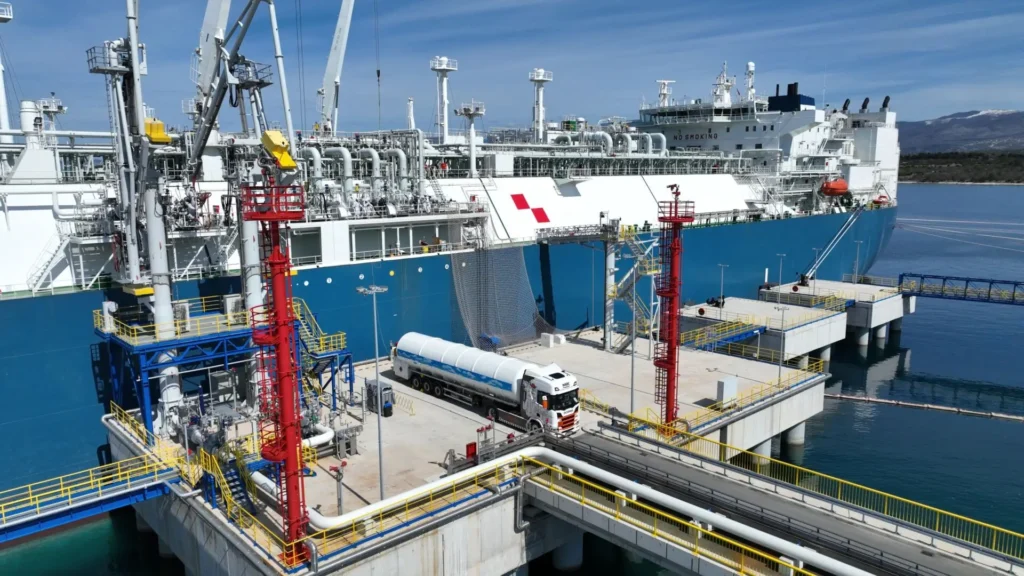The Union Minister for Petroleum and Natural Gas recently inaugurated India’s first small-scale liquefied natural gas (SSLNG) unit at GAIL (India) Ltd’s Vijaipur complex in Madhya Pradesh.
About Small-Scale Liquefied Natural Gas (SSLNG):
- SSLNG involves liquefying natural gas and transporting it through unconventional means on a much smaller scale compared to traditional large-scale liquefaction, regasification, and transportation processes.
- In SSLNG operations, LNG, which is natural gas in its liquid or super-chilled form, is delivered to industrial and commercial consumers using specialized trucks and small vessels, particularly in regions not connected by pipelines.
- In conventional applications like providing compressed natural gas (CNG) for vehicles and piped gas for households and manufacturing units, the purchaser typically regasifies the LNG using small vaporizers before supplying it to end-users.
- However, in cases where the fuel is used directly in its liquid form, it is supplied to end-users without undergoing regasification.
- The SSLNG chain may commence from a large-scale LNG import terminal, where instead of being regasified and distributed via pipelines, the LNG is transported to consumers using cryogenic road tankers or small vessels.
- The SSLNG chain can begin in locations with abundant natural gas, where small liquefaction plants can be established.
- The SSLNG unit at Vijaipur, within GAIL’s largest gas processing facility, exemplifies this approach.
- Key applications of SSLNG include marine fuel, power generation in off-grid areas, and transportation fuel.
About Liquefied natural gas (LNG):
- LNG is primarily methane (CH4) (85-95%), with some ethane (C2H6), cooled to liquid form for safe and convenient non-pressurized storage or transport.
- It occupies about 1/600th of the volume of natural gas in its gaseous state at standard temperature and pressure conditions.
- It is odorless, colorless, non-toxic and non-corrosive.
Adoption of LNG:
- Accelerated adoption of LNG across various sectors is essential to realize India’s vision of a Gas-based Economy (GBE).
- India aims to raise the share of natural gas in its primary energy mix to 15% by 2030, up from the current 6%.
Significance of promoting natural gas:
- Natural gas is considered significantly less polluting than conventional hydrocarbons such as coal and oil.
- Natural gas is also more cost-effective than oil, a significant factor considering that over 85% of India’s demand for oil is fulfilled through expensive imports.
- Transitioning a significant portion of India’s diesel consumption to LNG could result in substantial savings in foreign exchange.
- LNG emits lower levels of carbon dioxide and negligible amounts of particulate matter, nitrogen oxide, and sulfur dioxide emissions, making it a cleaner alternative.
- LNG offers a slightly longer range to vehicles than diesel with similar-sized fuel tanks, and is usually cheaper than crude oil, from which diesel is derived.
Challenges in adoption:
- One significant challenge in increasing gas consumption is the transportation of gas to areas not serviced by the country’s natural gas pipeline grid.
- This limitation also restricts the direct use of LNG as fuel for long-haul trucks and inter-city buses.
- Other challenges in India include the limited availability of LNG-powered vehicles, higher initial costs compared to diesel vehicles, a lack of financing options for LNG vehicles, and the absence of an LNG retail network.
Initiatives for promoting Gas based economy:
- National gas grid: A national gas grid aims to ensure the availability and equitable distribution of natural gas across the country.
- Unified gas pipeline tariffs: In 2023, India implemented unified gas pipeline tariffs to simplify gas pricing and encourage downstream demand.
- New Domestic Natural Gas Pricing Guidelines 2014: States that the price of domestic gas will be 10% of the Indian Crude Basket Price (ICP), as defined by the Petroleum Planning and Analysis Cell (PPAC).
- Draft LNG Policy 2021: Aims to promote the use of LNG in sectors that don’t currently use it as fuel, such as heavy transport and mining.
- Revised Guidelines for City Gas Distribution (CGD) Network 2022: The government has facilitated the rapid growth of CGD infrastructure.
- National Coal Gasification Mission (NCGM): It is a program launched by the Indian government to gasify 100 million tons of coal by 2030.
- Petronet: Jointly promoted by GAIL, Oil and Natural Gas Corporation Ltd (ONGC), Indian Oil Corporation Ltd (IOC), and Bharat Petroleum Corporation Ltd (BPCL), it has been advocating for increased adoption of LNG across various sectors.
About Gas Authority of India Limited (GAIL):
- GAIL (India) Limited is India’s largest natural gas company.
- Established in August 1984, it operates as a Central Public Sector Undertaking (PSU) under the Ministry of Petroleum & Natural Gas (MoP&NG).
- It is a Maharatna company.
| UPSC IAS Preparation Resources | |
| Current Affairs Analysis | Topperspedia |
| GS Shots | Simply Explained |
| Daily Flash Cards | Daily Quiz |



